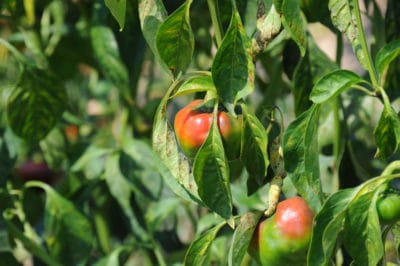Green peppers vs. red peppers
For the most part, peppers begin life as green fruits. All green bell peppers found in grocery stores are actually young red bell peppers. Peppers will reach their full-size green then require extra time to mature into bright colors.
In reality, almost all peppers are not green upon reaching full maturity. Different varieties will turn different shades of red, yellow, orange, chocolate, ebony, or white. If you desire green peppers, pick them when they have reached full size but not yet turned color.
As a pepper turns to red the flavor and heat are enhanced. Sweet red peppers develop sugars as they turn and spicy red peppers develop capsaicin. Green versions of these peppers are milder which is more desirable for certain dishes.
For example, jalapenos are most commonly used green in salsas, dishes, and for fresh eating. If left on the plant jalapenos will turn to a bright fire engine red. This red stage is ideal for drying because it traps the most flavor and heat.
Keep in mind that allowing fruit to reach a red stage on the plant sends a signal to the plant to stop producing. Allowing fruits to fully mature will result in a decrease in yield. If you’d like to pick red peppers but want a continuous yield, leave some fruits to mature and pick others green.
Days to Maturity
Each seed packet or seedling will have a tag with a ‘days to maturity’ section on it. This number refers to the amount of time between transplanting the seedling outside and it setting fruit.
Most peppers take 70-85 days to produce green fruits. It can take 100 days or more to produce red fruits on the same plant. Here are some popular varieties:
- California Wonder: A sweet heirloom bell pepper that takes 75 days to produce green fruit and 90 days for red. It will ripen to red but there are yellow varieties.
- Admiral Pepper: Large sweet peppers that take 80 days to produce green fruit. In 95 days fruit will mature to yellow.
- Banana Pepper: Mild to medium pepper. This early variety matures in 68 days. Fruit will ripen to yellow in 78 days.
- Jalapeno: Medium hot pepper. Depending on variety they take 60 days to ripen green and 75 days to ripen red.
Turning a green pepper red
It is possible to pick a pepper green and ripen it off the plant similar to a tomato. If you pick fruits with flushes of red, they may turn color on the counter. While it works sometimes this isn’t a reliable way to get green peppers to turn red off-plant.
The best way to ripen green peppers is in a paper bag. Place the fruit in a paper lunch bag with a banana. Fold the opening closed and leave the bag on the counter for a couple of days. The banana releases a gas that triggers the peppers to mature further. You can place multiple peppers in the bag and only one banana is needed.
Peppers that ripen off the plant will get more flavorful. They won’t be as sweet or spicy when compared peppers ripened on the plant. For the best tasting red peppers, allow them to ripen on the plant. If you’d like to keep your yields high, pick them green and ripen on the counter.
Tips on growing red peppers
Keep pepper seedlings and plants between 65 – 75° F (18-24° C). Exposure to temperatures outside of this range may cause pepper plants to slow growth, drop flowers, or stunt.
Avoid using soluble nitrogen fertilizers or ammonia-based nitrogen on pepper plants. They are sensitive to excessive nitrogen which can lead to a calcium deficiency and eventually blossom end rot. Use organic compost and organic liquid fertilizers to feed pepper plants for the best results.
Add crushed oyster shell, bone meal, or lime to the soil to give it a calcium boost. This along with avoiding heavy nitrogen inputs will keep peppers healthy and strong.
Water regularly and stick to a schedule. Pepper plants require one to two inches of water per week. As a rule of thumb, keep the soil damp but not wet and avoid over-watering.
